Determination of the Hazard Class of Ash After Coal Combustion by the Method of Biotesting
Svyatoslav Andreevich Bushumov , Tatyana Germanovna Korotkova
, Tatyana Germanovna Korotkova , Svetlana Jurevna Ksandopulo, Nataliya Vladimirovna Solonnikova and Vladimir Ivanovich Demin
, Svetlana Jurevna Ksandopulo, Nataliya Vladimirovna Solonnikova and Vladimir Ivanovich Demin
Kuban State Technological University, 350002 Russian Federation, Krasnodar, Moskovskaya Street, 2.
Corresponding Author E-mail: korotkova1964@m
DOI : http://dx.doi.org/10.13005/ojc/340130
Ash and slag wastes after coal combustion at power plants are usually considered as environmentally non-hazardous. The term "toxic" is not applied to ash and slag. This article discusses the results by researchers of several countries concerning the aspect of determination of hazard class of ash and slag wastes after coal combustion at power plants. Toxicity of ash and slag mixture has been determined experimentally using test organisms, contrary result has been obtained. Biotesting has been performed according to testing procedures (the Russian Federation) specified by the Federal Register, FR 1.39.2007.03222 and FR 1.39.2007.03223. While analyzing toxicity of ash and slag mixture after combustion of culm of Donetsk deposit (Russia), acute toxic impact water extract from waste on test organisms, Daphnia magna Straus and weeds Scenedesmus guadricauda, was revealed. Non-hazardous dilution factor water extract from waste has been detected, causing lethality of not more than 10% of daphnia in 96 h and deviation of quantity of weeds not higher than by 20% in 72 h in comparison with reference. Ash and slag wastes are classified as hazard class III-IV for environment which agrees with the results by other researchers.
KEYWORDS:Fly Ash; Slag Ash; Biotesting; Thermal Power Plant
Download this article as:| Copy the following to cite this article: Bushumov S. A, Korotkova T. G, Ksandopulo S. J, Solonnikova N. V, Demin V. I. Determination of the Hazard Class of Ash After Coal Combustion by the Method of Biotesting. Orient J Chem 2018;34(1). |
| Copy the following to cite this URL: Bushumov S. A, Korotkova T. G, Ksandopulo S. J, Solonnikova N. V, Demin V. I. Determination of the Hazard Class of Ash After Coal Combustion by the Method of Biotesting. Orient J Chem 2018;34(1). Available from: http://www.orientjchem.org/?p=41755 |
Introduction
Hazard class of ash and slag wastes is important in terms of environmental protection and health of inhabitants residing in vicinity of power plants. Ash dumps exert negative impact on environment due to dusting and on water sources due to effluents of toxic elements into surface and ground water. Ground waters are used as sources of water consumption in urban and rural areas. Determination of hazard class is required for assessment of environmental damage upon handling of wastes as well as for determination of waste disposal limits and costs of its storage. Classifying wastes as hazard class in Russia is based on calculations (quantitative chemical analysis) and experiments methods. Experimental method is based on biotesting of water extracts on test organisms which, according to Braginsky, are “sensors” of data on toxicity of medium. Biotesting in many countries is based on various hydrobionts: weeds, microorganisms, invertebrates, fishes. In Russia biotesting is legally permitted with crustaceans (daphnia or ceriodaphnia), weeds (Scenedesmus or Chlorella), and fishes (guppy or Danio). Biotesting methods consider for the extent of complex impact of all pollutants of tested sample, that is, provide integral assessment. Hazard class is determined on the basis of dilution factor of water extract at which no harmful impact on biological samples is detected.
This work discusses biotesting of ash and slag wastes of Novocherkassk state district power plant (Rostov region, Russia). The wastes are generated after combustion of Donetsk culm.
Related Works
The main fuel of power plant is coal, its combustion results in generation of ash and slag wastes. These wastes are stored in specialized ash dumps.
In Russia five hazard classes of wastes are established for environment (Decree of the Ministry of natural resources and environment of the Russian Federation, No. 536 dated December 04, 2014, “On approval of criteria of hazard classes I-V in terms of negative environment impact”), four hazard classes of wastes – for human health (SR 2.1.7.1386-03 “Sanitary rules of determination of hazard of toxic industrial and domestic wastes”, approved by the Ministry of health of the Russian Federation on June 16, 2003). The essence of both procedures is to calculate summary hazard index of waste K on the basis of a set of hygienic, toxicological and other properties of components (Table 1). Classifying of wastes as the fifth hazard class is based on impact water extract from waste without its dilution.
Table 1: Hazard classes of wastes
|
Hazard class |
«Criteria…» |
SR 2.1.7.1386-03 |
| Class 1– extremely hazardous |
106≥K≥104 |
K≥5·104 |
| Class 2 – highly hazardous |
104≥K≥103 |
5·104 ≥K≥103 |
| Class 3 – moderately hazardous |
103≥K≥102 |
103≥K≥102 |
| Class 4 – low hazardous |
102≥K≥10 |
102≥K |
| Class 5 – virtually non-hazardous |
10≥K |
– |
According to the researchers [1-3], ash and slag wastes of thermal power plants in the world are considered as non-hazardous (the term “toxic” is not applied to ash and slag) and nowhere in the world the content of microelements in ash of thermal power plants exceeds the approved maximum concentrations of microelements above which wastes are considered as hazardous. According to the USA regulations ash and slag after coal combustion with acid ash composition are considered as non-hazardous. This opinion [1-3] is confirmed by biotesting of water extracts from ash and slag after coal combustion with acid ash of numerous Russian deposits, that is, actually non-hazardous wastes for environment. Hazard class V is determined according to the established classification (Decree of the Ministry of natural resources and environment of the Russian Federation, No. 536 dated December 04, 2014). These researchers [3] discussed unjustified classification of ash and slag wastes as hazard class IV (low hazardous) instead of class V (virtually non-hazardous). Calculations reveal that ash and slag after combustion of numerous considered coals are classified as hazard class V; herewith, it is mentioned that this conclusion is not always confirmed by biotesting. Ash and slag after coal combustion contain potentially hazardous microelements, which can be hazardous if their concentration exceeds significantly maximum allowable concentration in soil (MAC(s)). Serbian researchers [4] also believe that the wastes generated at coal combustion facilities are usually characterized by low internal toxicity and are not hazardous for human health and environment.
Our investigations presented in this article do not confirm the conclusions summarized in [1-4]. Let us consider results by researchers of various countries concerning determination of hazard class of ash and slag after coal combustion at thermal power plants and state district power plant.
The work [5] discusses conventional insulation of ash dump by coating of their surface with natural vegetable soil with subsequent sowing of perennial grasses. It is established that the main bulk of heavy metals is held by plant roots and minor portion migrates into subsurface soil. Elements migrate from soil with gravitational waters, which comparatively rapidly penetrate across soil stratum. Such waters are known as lysimetric.
Results of chemical analysis of toxic elements in ash and slag are compared with normative concentration of monitored substances [6]. It follows that excess concentrations of toxic elements with regard to MAC(s) in gross form of ash and slag wastes are observed for chromium, plumbum, mercury arsenic. In 70 analyzed slag samples from power plants high content of chromium, plumbum, mercury, tin, and antimony are detected, their concentrations are significantly higher than MAC(s). It is experimentally found that ash and slag wastes upon contact with water are a source of toxic elements (vanadium, molybdenum, arsenic, nickel, zinc, manganese and chromium) in ground waters in the vicinity of ash and slag dumps and natural water sources. Significant migration of active forms of heavy metals (copper, nickel, zinc, plumbum) from ash and slag dumps into soils is observed despite low concentrations of nickel and zinc in gross form.
These researches [5, 6] confirm the fact that heavy metals penetrate into plants via root system and into ground waters with gravitational (infiltration) waters. As a consequence of motion of underground waters, they penetrate into surface water sources (lakes, rivers and so on), which leads to suppression of living organisms and plants. Therefore, accumulation of heavy metals results in continuous impairment of lithosphere and hydrosphere.
As mentioned in the Introduction, standard biotesting systems make it possible to assess reliably at laboratory scale the toxicity level of wastes aiming at environmental standardization of harmful impacts. In [7] the analytical results are compared according to two procedures used for assessment of ecotoxicity of waste samples and environment. These testing systems are from different taxon groups: entomostracans Daphnia magna and protozoans Paramecium caudatum. It is established that despite the pollution pattern of sample the most sensitive is testing on daphnia, testing with protozoansis characterized by significantly lower sensitivity. While comparing the extracts from ash and slag wastes from various regions of Russia neutralized by two different procedures different responses of test organisms were obtained.
Chemical analysis and biotesting of ash and slag wastes of Ltd “Siberian Barrel” (Russia) with ceriodaphnia and Paramecium revealed hazard class IV [8].
In [9] samples of fly ash (A, B, C, D, E) were obtained from European coal combusting thermal power plants (Great Britain – А, В, Austria – С, Italy – D, E). Elemental analysis was performed by inductively coupled plasma atomic emission spectroscopy (ICP-AES) and X-ray fluorescence (XRF). All samples are characterized with high amount of aluminum (about 100 g/kg) and silicon (about 200 g/kg), iron and calcium, as well as with traces of chromium, copper, manganese, and zinc. Toxicity of ash samples was determined according to EN 14735 (CEN, 2003). Rotifers (Brachionus calyciflorus) and crustaceans (Daphnia magna) were used as tested samples. 7 g of 35 ml solution of sodium chloride with 2 wt % (dilution factor 1:5) on the basis of deionized water were extracted in 10 min. After extraction the samples were tested on living organisms for 24 h. The highest lethality (nearly 100%) of daphnia was observed upon testing of ash A, which is stipulated by high content of heavy metals in sample.
The researchers [10] studied the influence of fly ash of heat and power plants with low calcium content on biota. Portland cement was used as a sample with high content of calcium silicate (70-80%) aiming at subsequent comparison with ash analyses. Fly ashes from Troitsk, Reftinsky, and Novotroitsk thermal power plants were analyzed. Microorganisms, hydrobionts and higher plants were used as test objects. It is mentioned that fly ash does not have toxic impact on microorganisms, such as microfungus (ascomycetous fungi). Water extract from ash samples has acute toxic impact on hydrobionts, Daphnia Magna (water extract of nearly all samples resulted in 100% lethality of test objects in 24 h). Analysis of these biotesting results of water extracts demonstrated minor toxic impact on higher plants, Avéna satíva (the highest lethality was 19.3%, which does not exceed the specified norm of 20%, but is sufficiently close to it).
Study of ash and slag wastes generated upon combustion of Kansk–Achinsk coals (Russia) [11] demonstrated that they contain highly and moderately hazard mineral substances and polycyclic aromatic hydrocarbons which are involved into natural cycles due to migration into ground waters, soil and surrounding air. Gross concentrations of chromium, manganese, nickel, cobalt, zinc, arsenic, copper in certain types of ash and slag wastes are by far higher than MAC in soil. In the disposal areas of ash and slag wastes the concentrations of iron, manganese and aluminum in ground waters and of manganese, copper, nickel, cobalt, plumbum and zinc in soil are significantly higher than MAC. The tests performed on warm-blooded animals proved that the ash and slag wastes generated upon combustion of Kansk–Achinsk coals are toxic with thresholds of acute impact of 90 mg/kg and damages of liver, kidneys and stomach, they exert mutagenic impact on microbe test objects, toxic impact on hydrobionts. Study of phytotoxic impact in tests upon wheat sprouting in artificial soil with addition of ash and slag wastes demonstrated that increase in ash and slag wastes portion in artificial soil suppresses sprouting and development of root system of seedlings, pronounced root growth inhibition is observed. It was determined by calculations that ash and slag wastes in terms of macrocomponent content are classified as hazard class III, and in terms of microcomponent content as hazard class IV. According to toxicometry of ash and slag wastes generated upon combustion of all Kansk–Achinsk coals are classified as hazard class III-IV of industrial wastes.
Therefore, the results of toxicity of ash and slag waste after coal combustion are various. The existence of toxic microelements in these wastes is evident. The test on daphnia, Daphnia Magna, is the most sensitive.
Methods
Biotesting of ash and slag mix was performed in accordance with Russian biological test procedures specified in the Federal register: FR 1.39.2007.03222 and FR 1.39.2007.03223. FR 1.39.2007.03222 is based on determination of lethality and variation in fertility of daphnia (Daphnia magna Straus, Cladocera, Crustacea) upon impact of toxic substances existing in the considered aqueous medium in comparison with samples without toxic substances (reference). Criterion of acute toxicity is lethality of at least 50% daphnia in 96 h in the considered water provided that in reference case lethality does not exceed 10%. FR 1.39.2007.03223 is based on recording of decrease in fluorescence of chlorophyll and decrease in quantity of protococcus cells: Scenedesmus quadricauda (Turp.) Breb. or Selenastrum capricornutum under laboratory conditions upon impact of toxic substances existing in the considered water extract (test) in comparison with reference sample without toxic substances (reference). Criterion of acute toxicity is suppression of fluorescence level of chlorophyll and decrease in quantity of weed cells by 50% and more in comparison with reference in 72 h exposure.
Results
In [12] we determined quantitative chemical analysis of ash and slag wastes from Novocherkassk state district power plant: ash mixture from transportation system; ash sampled from cyclone, and ash sampled from bag filters. It was found that the hazard index of ash mixture from transportation system (cumulative value) K is 96.904. It is close to 100. Thus, the environmental hazard class can be evaluated as III-IV. The values of Kifor ash from cyclone and ash from bag filters are 65.966 and 30.166, respectively. The environmental hazard class is IV.
It is known that averaged chemical composition of Earth in total is calculated on the basis of data on content of elements in meteorites. Clark number (or clark) of element expresses average content of chemical element in Earth crust, hydrosphere, space bodies and so on referring to total weight of this system and serves as reference of decreased or increased concentrations of chemical elements in mineral deposits, rocks, wastes and so on. Upon migration of elements their clarks are quantitative indices of their concentration. Clark are measured in mg/kg. Table 2 summarizes contents of chemical elements by various researchers and determined by us [12] in ash mixture after combustion of culm (Novocherkassk state district power plant, Russia), the rate of its pollution is assessed. The elements contained in coals and coal ashes in excess of clark are referred to as typomorphic or characteristic. Such elements include mercury, plumbum, manganese, selenium, antimony, bismuth, calcium. Mercury, plumbum, manganese, antimony and bismuth are heavy metals. Calcium is alkaline earth metal, its existence in soil is estimated positively. Necessity of selenium for living organisms, as the author in [13] believes, is not doubtful.
Table 2: Abundances of chemical elements, mg/kg
|
Chemical element |
Symbol |
In Earth crust, Taylor S.R. 1964 [14] |
In granite layer of continental crust Beus A. A. 1976 [15] |
In Earth crust [16] |
Content in ash mixture [12] |
Contamination level |
| Cadmium |
Cd |
0.2 |
0.16 |
6.1 |
< 0.1 |
weak |
| Copper |
Cu |
55 |
22 |
68 |
34.4±8.6 |
below clark |
| Mercury |
Hg |
0.08 |
0.033 |
0.08 |
< 0.1 |
above clark |
| Nickel |
Ni |
75 |
26 |
99 |
< 0.5 |
weak |
| Plumbum |
Pb |
12.5 |
16 |
13 |
17±4 |
above clark |
| Zinc |
Zn |
70 |
51 |
76 |
< 1.0 |
weak |
| Cobalt |
Co |
25 |
7.3 |
29 |
< 0.5 |
weak |
| Iron |
Fe |
56300 |
36000 |
62000 |
16655±4164 |
below clark |
| Manganese |
Mn |
950 |
700 |
1060 |
1138±285 |
above clark |
| Arsenic |
As |
1.8 |
1.9 |
1.8 |
< 0.1 |
below clark |
| Selenium |
Se |
0.05 |
0.14 |
0.05 |
< 0.1 |
above clark |
| Antimony |
Sb |
0.20 |
0.20 |
0.20 |
< 1.0 |
above clark |
| Bismuth |
Bi |
0.17 |
0.01 |
0.008 |
< 1.0 |
strong |
| Calcium |
Ca |
41500 |
25000 |
46000 |
145714±36429 |
above clark |
| Aluminum |
Al |
82300 |
80000 |
83000 |
62±16 |
weak |
In Russia regulations on allowable concentrations of substance in soil are valid [17, 18] (Table 3). Copper content in ash mixture, 34.4±8,6 mg/kg, exceeds MAC(s) more than in 10 times. Plumbum content in ash mixture, 17±4 mg/kg, exceeds MAC(s) in 3 times (active forms).
Crustaceans (Daphnia magna Straus) (Fig. 1) and weeds (Scenedesmus quadricauda) (Fig. 2) were elected as test objects for biotesting of ash mixture sampled from transportation system; from cyclone; and from bag filters. The biotesting procedure is illustrated in Fig. 3.
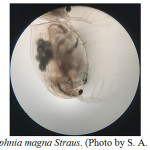 |
Figure 1: Daphnia magna Straus. (Photo by S. A. Bushumov). Click here to View figure |
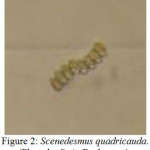 |
Figure 2: Scenedesmus quadricauda. (Photo by S. A. Bushumov). Click here to View figure |
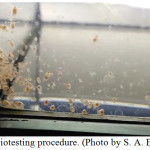 |
Figure 3: Biotesting procedure. (Photo by S. A. Bushumov). Click here to View figure |
Table 3: Content of elements, mg/kg
|
Chemical element |
Symbol |
Content in ash mixture, mg/kg |
MAC(s), mg/kg |
TAC (max), mg/kg |
| Cadmium |
Cd |
< 0.1 |
Carcinogenicity proved for human |
2.0 |
| Copper |
Cu |
34.4±8.6 |
3 a. f. |
132 |
| Mercury |
Hg |
< 0.1 |
2.1 g. c. |
– |
| Nickel |
Ni |
< 0.5 |
4 a. f. |
80 |
| Plumbum |
Pb |
17±4 |
32 g. c.; 6 a. f. |
130 |
| Zinc |
Zn |
< 1.0 |
23 a. f. |
220 |
| Cobalt |
Co |
< 0.5 |
5 a. f. |
– |
| Iron |
Fe |
16655±4164 |
– |
– |
| Manganese |
Mn |
1138±285 |
1500 g. c. |
– |
| Arsenic |
As |
< 0.1 |
2 g. c. |
10 |
| Selenium |
Se |
< 0.1 |
10 [13] |
– |
| Antimony |
Sb |
< 1.0 |
4.5 g. c.. |
– |
| Bismuth |
Bi |
< 1.0 |
– |
– |
| Calcium |
Ca |
145714±36429 |
– |
– |
| Aluminum |
Al |
62±16 |
– |
– |
Note: MAC(s) (mg/kg) – Maximum allowable concentration of chemical element in soil [17];
TAC (mg/kg) – Tentative allowable concentration of chemical element in soil [18];
a.f. – active form; g.c. – gross content; blank – not determined
In the course of toxic analysis of ash mixture (Tables 4 and 5) acute toxic impact of water extract from waste on test organisms was detected: Daphnia magna Straus and weeds Scenedesmus quadricauda; non-hazardous dilution factor of water extract was determined causing lethality of not more than 10% of daphnia in 96 h and deviation of weed quantity not more than by 20% in 72 h regarding reference.
Table 4:Results of toxicology tests
| Description of waste | Ash and slag mixture after coal combustion, low hazardous | ||
| Biotesting medium | Water extract from waste | ||
| Water extract pH | 7.43 | ||
|
Test sample |
Duration, h |
Non-hazardous dilution factor |
Assessment of tested sample |
| Daphnia magna Straus FR 1.39.2007.03222 |
96 |
w/o d. <NHRD<100 |
Acute toxic impact |
| Scenedesmus quadricauda FR 1.39.2007.03223 |
72 |
w/o d. <NHRD<100 |
|
Note: w/o d – without dilution
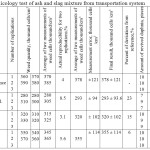 |
Table 5: Toxicology test of ash and slag mixture from transportation system Click here to View table |
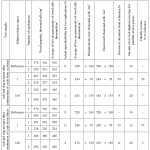 |
Table 6: Toxicology test of ash and slag mixture from cyclones and bag filters Click here to View table |
According to the biotesting results the waste is classified as environment hazard class IV.
Discussion
X-ray structure analysis evidences that the ash mainly contains crystalline quartz, anhydride, compounds of calcium oxide with iron oxides and aluminum (dicalcium silicate, tetracalcium alumoferrite, calcium aluminates, calcium ferrites); then, glass phase, hematite and impurities, as well as CaO and MgO in free state.
The performed studies of physical properties of dry ash demonstrated that the ash is mainly comprised of regular globular particles of brownish color without impurities. The sizes of spherical particles range from 0.5 µm to 20 µm, diameter of single particles reaches 30…40 µm. The ash is characterized by high density in comparison with acid ashes after combustion of bituminous coals. Thus, the ash bulk density is in the range of 1200…1500 kg/m3, the real density is in the range of 2900…2950 kg/m3, specific surface area is 3021 cm2/g. The ash after combustion of brown coal at power plane contains high amounts of calcium, the content of calcium oxide is 25…40%, and the content of silica and alumina in this ash is significantly lower, 30% and 15%, respectively. The content of unburned particles and alkaline components is low. All these factors make it possible to use the ash as raw stock for production of mineral fiber.
Our studies of ash particle size distribution [19] demonstrated that the ash is finely dispersed, its specific surface area is high, it is a final product of short-term high temperature annealing. Its mineral portion contains annealed, vitrified and partially crystallized particles characterized by various degree of chemical and hydraulic activity, it contains minor amounts of organic particles exposed to burning. The ash can be efficiently used as additive for production of concretes, mortars, and dry construction mixes. This would allow to recover wastes of thermal power production and to decrease prime costs of construction materials.
Conclusions
Toxicology tests of water extract after coal combustions demonstrated that the considered sample exerts acute toxic influence. Ash and slag wastes are classified as environmental hazard classes III-IV. Long term storage of ash and slag in dumps can result in variation of hazard class and toxicity. Hygienic assessment is required including laboratory tests.
References
- Dik E.P.; Soboleva A.N. Otsenka stepeni opasnosti zoloshlakovykh othodov TES dlya okruzhaiushchei sredy i zdorov`ia cheloveka [Assessment of hazard of ash and slag wastes of thermal power plants for environment and human health] Proceedings, 2nd Seminar, Ash and slag of power plants: removal, transport, processing, storage, Moscow, April 23–24, 2009.
- Dik E. P.; Soboleva A.N.; Smirnova O.A. Klassy opasnosti zoloshlakov teplovykh elektrostantcii dlya okruzhaiushchei sredy [Environmental hazard classes of ash and slag of thermal power plants]. Teploenergetika; 2011, 6: 58-62 .
- Burdina V.M.; Soboleva A.N.; Dik E.P.; Terekhova V.A. Effekt raznykh sposobov neitralizatsii na opredelenie ekotoksichnosti othodov TES [Effect of various neutralization techniques on determination of environmental toxicity of wastes of thermal power plants]. Ecological systems and devices; 2007, 10: 37-39.
- Čudić, V.; Kisić, D.; Stojiljković, D.; Jovović, A. Ash From Thermal Power Plants As Secondary Raw Material. Arh Hig Rada Toksikol; 2007, 58: 233-238
CrossRef - Belozerova T.I. Rekul`tivatsiia zolootvalov teplovykh elektrostantcii v usloviiakh Severa [Recovery of ash wastes of thermal power plants in North]. Cand. Thesis. Arkhangelsk, institute of Ecological Problems of the North, Ural Branch, Russian Academy of Sciences, 2006, pp. 20.
- Zhuravleva N.V. Obosnovanie, razrabotka i razvitie metodov otscenki vliianiia dobychi i pererabotki uglei kuznetckogo ugol`nogo basseina na ekologicheskoe sostoianie prirodnoi sredy [Substantiation and development of assessment techniques of influence of coal mining and processing at Kuznetsk coal basin on environment]. Doctoral thesis. Kemerovo, Institute of Coal Chemistry and Materials Science, Siberian Branch, Russian Academy of Sciences, 2017.
- Terekhova V.A. Tekhnologii biotestirovaniia v otsenke ekotoksichnosti othodov [Biotesting in assessment of environmental toxicity of wastes]. Ecology of Production, 2009, 1: 48-52.
- Vigand, A.K.; Il`ina E.G.; Ivanova S.A. Khimicheskii analiz i biotestirovanie zoloshlakovykh otkhodov [Chemical analysis and biotesting of ash and slag wastes]. South-Siberian Scientific Bulletin; 2014, 3 (7): 97-100.
- Tsiridis, V.; Samaras, P.; Kungolos, A.; Sakellaropoulos, G. P. Application of Leaching Tests for Toxicity Evaluation of Coal Fly Ash. Environmental Toxicology; 2006, 21: 409-416.
CrossRef - 10 Kozhukhova N.I.; Lebedev M.S.; Vasilenko M.I.; Goncharova E.N. Ecology-toxicology study of low-calcium solid wastes from power plants. International Journal of Pharmacy and Technology; 2016, 8(3): 15349-15360.
- Andreeva S.G. Gigienicheskaya otsenka zoloshlakovykh otkhodov, obrazuyushchikhsya pri szhiganii uglei Kansko-Achinskogo basseina [Hygienic assessment of ash and slag wastes after combustion of coals of Kansk-Achinsk basin]. Cnad. Thesis. Kemerovo State Medical Academy, Center of hygiene and epidemiology in Krasnoyarsk region, 2006, pp. 20.
- Korotkova T.G.; Ksandopulo S.Ju.; Bushumov S.A.; Burlaka S.D.; Say Yu.V. Quantitative Chemical Analysis of Slag Ash of Novocherkassk State District Power Plant. Oriental Journal of Chemistry; 2017, 33(1): 186-198.
CrossRef - Sindireva A.V. Vliyanie selena na himicheskii sostav pochvy i rastenii v usloviiakh yuzhnoi lesostepi omskoi oblasti [Influence of selenium on chemical composition of soils and plants in Southern forest steppe in Omsk oblast]. Bulletin of Omsk State Agrarian University; 2011, 4(4): 17-22.
- Taylor, S.R. Abundance of chemical elements in the continental crust; a new table. Geochimicu et Cosmochimicn Acta; 1964, 28: 1273 – 1285.
CrossRef - Dobrovol`ski, V.V. Osnovy biogeohimii [Foundations of biogeochemistry]: Guide book for students of higher schools. Akademiya, Moscow, 2003.
- Greenwood, N.; Earnshaw, A. Chemistry of the Elements. Binom, Moscow, 2008, pp. 670.
- Gigienicheskie normativy GN 2.1.7.2041-06 Predel`no dopustimye koncentratsii (PDK) himicheskikh veshchestv v pochve [Hygienic Norm 2.1.7.2041-06. Maximum Permissible Concentrations of Chemical Substances in Soil]
- Gigienicheskie normativy GN 2.1.7.2042-06 Orientirovochno-dopustimye koncentratsii (ODK) khimicheskikh veshchestv v pochve [Hygienic Norm 2.1.7.2042-06. Tentatively Permissible Concentrations of Chemical Substances in Soil
- Bushumov, S.A.; Korotkova, T.G.; Siukhov, H.R.; Burlaka, S.D.; Hachaturov, V.N. Granulometricheskii sostav zoly Novocherkasskoi GRES [Ash particle size distribution of Novocherkassk state district power plant]. Scientific journal, Kuban State Agrarian University; 2016, 124(10): 799-808.

This work is licensed under a Creative Commons Attribution-NonCommercial-ShareAlike 4.0 International License.

This work is licensed under a Creative Commons Attribution 4.0 International License.









